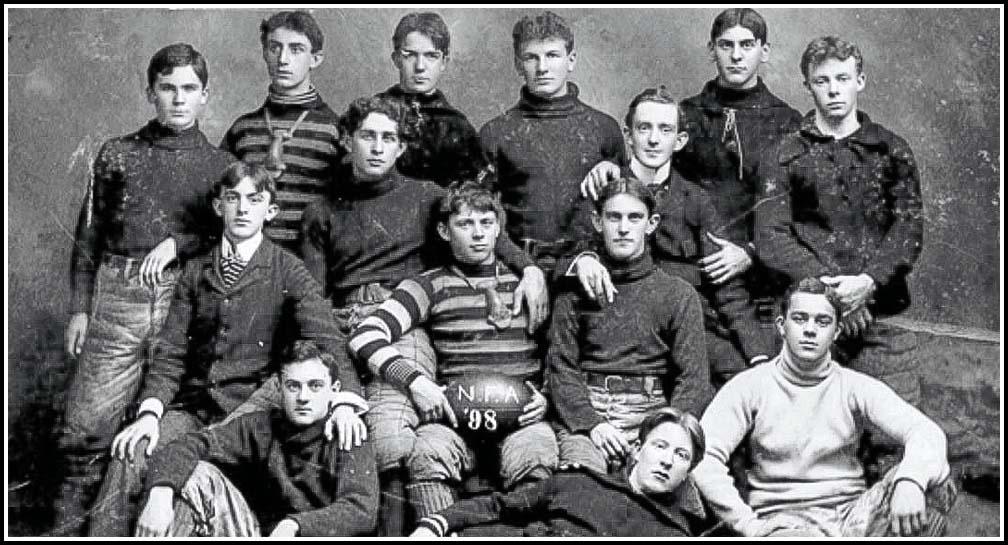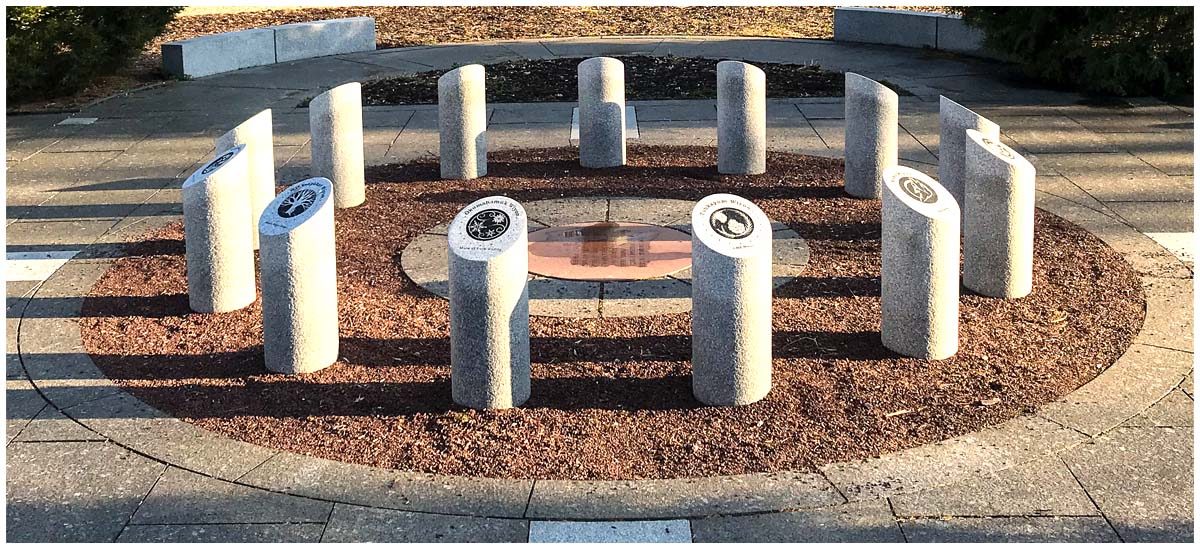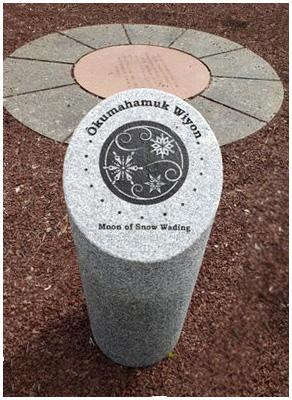Masonic Temple : 91 Broadway

Built in 1894 : As seen in 1907
The first charter for Norwich’s Somerset Lodge, No. 34, Free and Accepted Masons was granted in 1767. For the first several years the group met in rooms of private homes. From 1801-1850 a brick “store chamber” served as an appropriate meeting place. And, from June 1850 to June 1865 the lodge room in Uncas Hall was rented from the Independent Order of Odd Fellows, another fraternal organization.
On June 19, 1865 the Uncas Hall was remodeled and was dedicated specifically for the use of Masonry purposes by the fraternity of Somerset Lodge #34.
The Masonic Temple Corporation of Norwich was organized April 20, 1892. Two years later, in 1894, the Masonic Temple, shown on the left, was opened and dedicated solely for use of the Masons. It was the first building in the world erected by Masons exclusively for Masonry that allowed all the York and Scottish Rite degrees to be conferred, except the thirty-third and last degree of the Ancient Accepted Scottish Rite.
Costello Lippitt, mayor of Norwich from 1908-1910, was the Treasurer of the Corporation and Howard L. Stanton, an esteemed member of the Norwich fire department for more than 58 years, was also on the Board of Directors and the Building Committee of the Corporation.
UNCAS HALL – 47 Water Street
Uncas Hall has been used for various purposes over the years. Many Norwich-based fraternal organizations used it as a gathering place from 1847 through 1894.
In March 1847, the Independent Order of Odd Fellows, Uncas Lodge No. 11, dedicated a portion of Uncas Hall for their use. In May 1864, the Ancient and Accepted Scottish Rite began using a fourth-floor room in Uncas Hall, and in June 1865, the Free and Accepted Masons, Somerset Lodge No. 34, also began meeting at Uncas Hall. Later, in 1883, both the Knights of Pythias, Wauregan Lodge No. 6, and the Knights of Pythias, Endowment Rank used Uncas Hall.
Uncas Hall was a popular meeting place. Soon after the Civil War broke out, Captain Frank Chester and his men answered Governor William A. Buckingham’s call to arms. On April 22, 1861, they mustered in front of Uncas Hall before marching to the Norwich & Worcester Train Depot for their service.
In 1870, the Hall was owned by the Uncas Hall Company, with Archa P. Willoughby as President and John L. Devotion as Secretary. Col. John L. Devotion was one of the founders of Odd Fellowship in Norwich and was also a member of the Uncas Hall building committee
Today, the former location of Uncas Hall is used as a multi-level parking garage.
The complete list of sources may be found by clicking the “Bibliography” button below and then typing “Uncas Hall” in the SEARCH box.
This 1911 postcard clearly shows the location of the Masonic Temple. It is the grayish-white building across the street from Norwich Court House (and City Hall).
At this point-in-time, many of the leaders of Norwich’s local government were also members of fraternal organizations such as the Free and Accepted Masons and the Independent Independent Order of Odd Fellows. It is most likely that it was no coincidence that City Hall and the Masonic Temple were in such close proximity.
By 1928 the Masons had built a new temple at the corner of Washington & Sachem Streets and their meetings from that point forward were held at the new temple. The temple at 91 Broadway, was destroyed by fire in the 1930s. Today, the area is used as a parking lot for City Hall visitors and employees.
Acknowledgements
“A Modern History of New London County Connecticut – Vol. 2,” 1922, pp 514-519, by Benjamin Tinkham Marshall
Public Domain
The complete list of sources may be found by clicking the “Bibliography” button, and, then typing “91 Broadway” or “Uncas Hall” in the SEARCH box.
Masonic Temple
Corner of Washington & Sachem Streets
The Masonic Temple, formerly located on the corner of Washington and Sachem Streets, was built in 1928 by the Fraternal Order of Free and Accepted Masons in Norwich. It was designed by the Norwich architectural firm Cudworth & Woodworth, (architects of many other impressive buildings in Norwich). It became the home of Somerset Lodge No. 34, Norwich, Connecticut.
The building, a substantially larger structure than the Mason’s previous Temple at 91 Broadway in Norwich, was also home to several other of the city’s leading fraternal organizations.
The large, 2-story, brick and limestone building featuring Italian Renaissance Revival architecture was considered by many as a unique gem of Norwich. As seen in the images on the left, the front face of the building was adorned with many symbols of Free Masonry. During the construction of the building in 1928, a time-capsule was also buried near its cornerstone.
*Place cursor over image to magnify
In addition to the use of the building by fraternal organizations, many community gatherings, social events, and performances were conducted in the temple until 1988. The photo on the left shows a scene from one of the many dance recitals held in the theater.
The 900-seat auditorium hosted the Norwich Summer Theater series for several years. Many famous performers, such as Frank Sinatra, Peter Lorre, and Gypsy Rose Lee, attended and starred in shows at the Masonic Temple.
Several fire code violations halted public use of the building in 1988. After that, the building bounced between various owners and, at one point, was scheduled to become a technical education center. After the City of Norwich bought the building and land from the Masons in 1995, it stood unused for several years.
However, the existence of the temple was fatally flawed for a reason more important than fire code violations. It was built in the center of Royal Mohegan Burial Ground. In fact, the land upon which the temple sat, held the remains of many Mohegan chiefs, including, Uncas. The City of Norwich sold the Masonic Temple to the Mohegan Tribe in 1999 and by the end of October 2006 the building was demolished.
Please refer to the Royal Mohegan Burial Ground placemark for much more detail.
Acknowledgements
“Once Upon A Time: Norwich Has A Long History of Quality Theater,” (07/26/2009), by Bill Stanley
“Masonic Temple Demolition,” October 2006, by Megan McGory
Public Domain
The complete list of sources may be found by clicking the “Bibliography” button, and, then typing “Washington Street Masonic Temple” in the SEARCH box.
Norwich Free Academy
The Norwich Free Academy (NFA) was founded on the ideas of removing education from political pressures and serving every student, regardless of social class or gender. It was incorporated in May 1854 and was opened in 1856. NFA was endowed with a $100,000 ($3.13 million in today’s dollars) grant donated by 45 generous citizens of Norwich. The founding of the academy was due to the suggestion, as well as to the persevering efforts of Reverend John P. Gulliver.
NFA’s first principal was Elbridge Smith, former principal of Deerfield Academy and a graduate of Brown University. In 150 years, only a dozen distinguished leaders have succeeded him.

In 1859, only 3 years after NFA was opened, Norwich celebrated its 200th Jubilee. On the first day of the Jubilee a large procession began at Franklin Square and ended at Chelsea Parade, across the street from NFA. Governor William A. Buckingham, addressed the audience.
The dinner tent, shown of the left, hosted 2,500 people. Speeches were made in the tent, and on the last day of the jubilee, an elegant formal ball was hosted.
The original NFA building can be seen in the background.
The original NFA building, as seen in 1905, is shown in the bottom-left corner of the postcard. It was an eleven-room Italianate structure designed by W.T. Hallett. The building was dedicated in 1856. In 1911 it was replaced by the, still-standing, Tirrell Building.
The upper right photo shows Slater Hall as it appeared in 1905. The Slater Memorial Building, dedicated in 1886, was a gift from William A. Slater. It was the second structure built on campus and housed the Slater Memorial Museum.
At the center of the Main Entrance to NFA and the Slater Museum is the Norwich Free Academy Seal. The words Learning, Art, and Industry are featured. Throughout NFA’s history the meanings of these words have been manifested in action.
Learning : The original NFA building was an 11-room classroom building. Since its inception NFA has focused on enriching students minds with knowledge and developing possibilities to fulfill their potential.
Art : Even before 1900 the Norwich Art School’s studios were housed at NFA. In 1907, a major facility, the Charles A. Converse Art Building was opened and became the home of the Norwich Art school. This school has inspired and trained students for more than 110 years.
Industry : The Manual Training Building was added in 1895. Inside its walls industrial trades, such as fine printing, machining, drafting and woodworking were taught.
Oldest High School Football RIvalry in the United States
More than 145 years ago, the first game of the oldest high school football rivalry in the country took place on May 12, 1875. The rivalry between the Norwich Free Academy and the Bulkeley School for Boys in New London continued until 1951, when Bulkeley merged with New London’s Chapman Tech to become New London High School. In the early years the Norwich-based games were played in Williams Park (today’s Chelsea Parade) and the New London-based games were played were played in various fields, including Cannonball Park and the Admiral Billard Academy field.

For the first 35 years the fierce NFA teams dominated. It is believed they won every game but one until 1910. And, in the one game in which Bulkeley triumphed, it is believed that their team included non-Bulkeley student players.
Over the years, there have been countless legends, stories, accusations, and counter accusations. In 1886, NFA officials discovered a member of the Bulkeley faculty was a star player in the lineup, a far from uncommon occurrence in the early days of high school football.
In 1902, the score already 130-0 in NFA’s favor, Bulkeley gave up a few minutes into the second half. It remains the most points ever scored in a football game by one team in Connecticut history.
In 1909, the NFA timekeeper allowed play to extend thirteen minutes during which time NFA scored a touchdown to tie the game. He ran for his life when the error was discovered.
Usually, the games were played annually, but there were exceptions. In 1921, and then again for a brief period in 1970s, the games were held twice a year. Since the year 2000, the gridiron battle has taken place as the final regular-season game on Thanksgiving Day. The rivalry burns brightly to this day and is expected to continue for many years to come.
The book listed in the Info Source below provides an excellent, in-depth history of the rivalry.
Acknowledgements
“The Norwich Free Academy V. New London Football Rivalry,” 2012, by Brian Girasoli
USA Today High School Sports
The complete list of sources may be found by clicking the “Bibliography” button, and, then typing “rivalry” in the SEARCH box.
The photo shown here was taken several days after Veteran’s Day in 2019. NFA respects and honors our Veterans.
The Cranston Building is shown in the center of the photo. It houses classrooms for commercial courses, a planetarium and an observatory. It is named for former industrial arts teacher, Frederick Cranston, and was built in 1933.
The Norton Gymnasium, right side, houses a dance studio, a fitness center, and a gymnasium. The building was built using a donation from Ella M. Norton in 1929.
Acknowledgements
“The Norwich Jubilee, A Report of the Jubilee at Norwich, Connecticut on the 200th Anniversary of the Settlement of the Town”, (1859), page 112, by John W. Stedman
Norwich Free Academy – History
by Bob Dees
The complete list of sources may be found by clicking the “Bibliography” button, and, then typing “Free Academy” in the SEARCH box.
Royal Mohegan Burial Ground
The Royal Mohegan Burial Ground is located at the corner of Washington and Sachem Streets in Norwich. Several images of the completed public monument, blessed in August 2008, are shown below. The monument is an open green surrounded by a circular arrangement of short, white granite columns, each engraved with one of the 13 moons that make up the Mohegan year. At the center, a flat red stone symbolizes the spiritual life force felt throughout the universe.

Burial Ground


Snow Wading
When viewed from the air, the shape of the burial ground clearly resembles the seal of the Mohegan Tribe.

Mohegan Seal
MOHEGAN SEAL
The seal is a black circle ringed in red. Within it is a complex figure based upon an ancient Mohegan motif. A red dot in the center is circled by thirteen smaller white dots. These are enclosed in a white narrow border forming a square. Attached to each side of the square is a royal blue semicircle edged in white. From each corner of the square a diagonal white line aims outward, its end separating into two curves.
The four semicircular domes point to each of the four sacred directions, represent the back of “Grandfather Turtle upon whom the earth was formed”, and recall the shape of the old wigwam dwellings of the Mohegan people. The four diagonal lines are four sacred trees and represent a “branching out towards future generations”. The thirteen white dots recall the thirteen moons in a lunar year, the thirteen sections on a turtle’s back, and thirteen generations since Uncas, the great leader of the Mohegan. The central red dot is the “Sacred Center Circle” of the spiritual life force felt throughout the universe. —From the Mohegan Tribal Headquarters, Uncasville Connecticut —
The history surrounding the Royal Mohegan Burial Ground is long and contentious. Prior to the sale of the 9-mile-square tract, the Mohegan used this ancient site to bury tribal leaders. Hundreds, and possibly thousands, of Mohegans, including Uncas, were buried in the cemetery. The exact location of Uncas’s grave is unknown.
When Uncas signed the deed to Norwich over to Major John Mason, it included a promise that the Mohegan would retain ownership of the burial ground. Unfortunately, this promise was not kept. The land upon which the burial ground sits was used by non-Mohegan people for many purposes for over 300 years. In the 1800s, homes were built on the site. The Mohegan tried to keep the 3.4-acre site undeveloped since the last tribal burial there in 1876. They sued unsuccessfully in the 1890s, arguing that the land had been illegally encroached upon.
After the Masonic Temple was built directly upon the burial ground in 1928. The Mohegan again sued unsuccessfully in the 1930s. However, public use of the Masonic Temple halted in 1988, and the Masons sold both the land and building to the City of Norwich in 1995. Four years later, in 1999, the city sold the land and building to the Mohegan Tribe.
On August 15, 2008, after much patience, discussion, planning, and hard work, the Royal Mohegan Burial Ground was blessed, and the Mohegan buried there were honored. The tribal Chairman Bruce “Two Dogs” Bozsum offered a traditional prayer and burned sage to cleanse the space. He said the ceremony was in honor of his ancestors and “to right a great wrong that happened to the Mohegan people.”
The site is open to all visitors.
Acknowledgements
“Mohegans Restore Ancient Tribal Burial Ground,” 06/22/2007, by Associated Press
“Mohegans Bless Burial Ground – Years of Protest, Battles End With Peace, Closure,” 08/16/2008, by Greg Smith
Facebook – Mohegan Tribe
The complete list of sources may be found by clicking the “Bibliography” button, and, then typing “Royal Mohegan” in the SEARCH box.